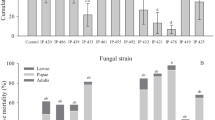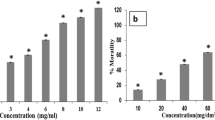Abstract
The susceptibility of the adult and larval stage of housefly, Musca domestica L. (Diptera: Muscidae), to two entomopathogenic fungi, Metarhizium anisopliae (Metsch.) Sor. and Beauveria bassiana (Bals.) Vuill., was evaluated under laboratory and simulated field bioassays. Bioassays on adult houseflies were carried out at different conidial concentrations ranging from 103 to 109 conidia/ml in petri plate and minichamber assays. Absolute mortality was observed within 4–5 days at all the concentrations tested. M. anisopliae was found to be more effective with LC50 of 6.75 × 107 conidia/ml compared with 1.21 × 108 conidia/ml of B. bassiana in petri plate bioassay. Similar trend was observed in minichamber bioassay. Larvicidal activity evaluated through petri plate bioassay also indicated that M. anisopliae was more effective larvicide with LC50 of 4.1 × 108 conidia/ml as against 3.31 × 109 conidia/ml of B. bassiana. Larvicidal activity was further evaluated in simulated field condition of decaying waste matrix using dry conidial formulations (108 conidia/g) of both the fungi. Larval mortality obtained in this assay was 43% (B. bassiana) and 63% (M. anisopliae). Remarkably better performance of M. anisopliae as an adulticidal and larvicidal agent over B. bassiana in laboratory bioassays as well as simulated field conditions suggests that it may have good potential to become part of an integrated housefly control program.





Similar content being viewed by others
References
Abbott WS (1925) A method for computing the effectiveness of an insecticide. J Econ Entomol 18:265–267
Acevedo GR, Zapater M, Toloza AC (2009) Insecticide resistance of house fly, Musca domestica (L.) from Argentina. Parasitol Res 105:489–493
Barin A, Arabkhazzeli F, Rahbari S, Madani SA (2010) The house fly, Musca domestica, as a possible mechanical vector of Newcastle disease virus in the laboratory and field. Med Vet Entomol 24:88–90
Barson G, Renn N, Bywater AF (1994) Laboratory evaluation of six species of entomopathogenic fungi for the control of house fly (Musca domestica L.), a pest of intensive animal units. J Invertebr Pathol 64:107–113
Bellini R, Mullens BA, Jespersen JB (1992) Infectivity of two members of the Entomophthora muscae complex (Zygomycetes: Entomophthorales) for Musca domestica (Dipt.: Muscidae). Entomophaga 37:11–19
Bukhari T, Middelman A, Koenraadt CJM, Takken W, Knols BGJ (2010) Factors affecting fungus-induced larval mortality in Anopheles gambiae and Anopheles stephensi. Malar J 9:22
Carswell I, Spooner-Hart R, Milner RJ (1998) Laboratory susceptibility of Musca domestica L. (Diptera: Muscadiae) and Bactrocera tryoni (Frogatt) (Diptera: Tephritidae) to an isolates of Metarhizium anisopliae (Metsch) Sorokin. Aust J Entomol 37:281–284
Dimbi S, Nguya KM, Slawomir AL, Sunday E, Jones KM (2003) Pathogenicity of Metarhizium anisopliae (Metsch.) Sorokin and Beauveria bassiana (Balsamo) Vuillemin, to three adult fruit fly species: Ceratitis capitata (Weidemann), C. rosa var. fasciventris Karsch and C. cosyra (Walker) (Diptera :Tephritidae). Mycopathol 156:375–382
El-Sinary NH, Rizk SA (2007) Entomopathogenic fungus, Beauveria bassiana (Bals.) and gamma irradiation efficiency against the greater wax moth, Galleria melonella (L.). American-Eurasian J Sci Res 2:13–18
Forester M, Klimpel S, Sievert K (2009) The house fly( Musca domestica) as a potential vector of metazoan parasites caught in a pig-pen in Germany. Vet Parasitol 160:163–167
Geden CJ, Rutz DA, Steinkraus DC (1995) Virulence of different isolates and formulation of Beauveria bessiana for house flies and the parasitoid Muscidifurax raptor. Biol Control 5:615–621
Gindin G, Levski S, Glazer I, Soroker V (2006) Evaluation of the entomopathogenic fungi Metarhizium anisopliae and Beauveria bassiana against the red palm weevil Rhynchophorus ferrugineus. Phytoparasit 34:370–379
Goettel MS, Eilenberg J, Glare T (2005) Entomopathogenic fungi and their role in regulation of insect populations. Compr Mol Insect Sci 6:361–406
Howard J (2001) Nuisance flies around landfill; pattern of abundance and distribution. Waste Manage Res 19:308–313
Hussain MA, Kumar P, Prasad CS (2009) BIPM module for white grub management in sugarcane. “5th International conference on Biopesticides: Stakeholders’ perspectives” Apr. 26–30, 2009. pp 197
Kaufman PE, Reasor C, Rutz DA, Ketzis JK, Arends JJ (2005) Evaluation of Beauveria bassiana applications against adult house fly, Musca domestica, in commercial caged-layer poultry facilities in New York State. Biol Control 33:360–367
Lecuona RE, Turica M, Tarocco F, Crespo DC (2005) Microbial control of Musca domestica (Diptera: Muscidae) with selected strains of Beauveria bassiana. J Med Entomol 42:332–336
Leles RN, Sousa NA, Rocha LFN, Santos AH, Silva HHG, Luz C (2010) Pathogenicity of some hypocrealean fungi to adult Aedes aegypti (Diptera: Culicidae). Parasitol Res 107:1271–1274
Lohmeyer KH, Miller JA (2006) Pathogenecity of three formulation of entomopathogenic fungi for control of adult haematobia irritans (Diptera: Muscidae). J Econ Entomol 99:1943–1947
Maitland DP (1994) Parasitic fungus infecting yellow dungflies manipulates host perching behaviour. Proceeding of royal society of London. B Biol Sci 258:187–193
Malik A, Singh N, Satya S (2007) House fly (Musca domestica): a review of control strategies for a challenging pest. J Environ Sci Health B 42:453–469
Mnyone LL, Kirby MJ, Mpingwa MW, Lwetoijera DW, Knols BGJ, Takken W, Koenraadt CJM, Russell TL (2010) Infection of Anopheles gambiae mosquitoes with entomopathogenic fungi: effect of host age and blood-feeding status. Parasitol Res doi:10.1007/s00436-010-2064-y
Pimental D, Perkins JH (1980) Pest control: cultural and environmental aspects. Westview, Colorado
Pirali-Kheirabadi K, Haddadzadeh H, Razzaghi-Abyaneh M, Bokaie S, Zare R, Ghazavi M, Shams-Ghahfarokhi M (2007) Biological control of Rhipicephalus (Boophilus) annulatus by different strains of Metarhizium anisopliae, Beauveria bassiana and Lecanicillium psalliotae fungi. Parasitol Res 100:1297–1302
Shah PA, Pell JK (2003) Entomopathogenic fungi as biological control agents. Appl Microbiol Biotechnol 61:413–423
Shono T, Scott JG (2003) Spinosad resistance in the house fly, Musca domestica, is due to a recessive factor on autosome 1. Pestic Biochem Physiol 75:1–7
Siri A, Scorsetti AC, Dikgolz VE, Lopez Lastra CC (2005) Natural infection caused by the fungus Beauveria bassiana as a pathogen of Musca domestica in the neotropic. Biol Control 50:937–940
SPSS (1997) Statistical product and service solution, system user’s guide, version 17.5.
Srinivasan R, Jambulingam P, Gunasekaran K, Boopathidoss PS (2008) Tolerance of house fly, Musca domestica (Diptera: Muscidae) to dichlorovos (76% EC) an insecticide used for fly control in the tsunami-hit coastal villages of southern India. Acta Trop 105:187–190
StatPlus (2007) Professional build 4.9.0.0. AnalystSoft.
Steinkrauss DC, Geden CJ, Rutz DA, Kramer JP (1990) First report of the natural occurrence of Beauveria Bassiana (Moniliales: Moniliaceae) in Mucsa domestica (Diptera: Muscadiae). J Med Entomol 27:309–312
Sukontason K, Bunchoo M, Khantawa B, Sukontason K, Piangjai S, Choochote W (2000) Musca domestica as a mechanical carrier of bacteria in Chiang Mai, North Thailand. J Vector Ecol 25:114–117
Watson DW, Geden CJ, Long SJ, Rutz DA (1995) Efficacy of Beaauveria bassiana for the controlling of the House fly and Stable fly (Diptera: Muscadiae). Biol Control 5:405–411
Watson DW, Rutz DA, Long SJ (1996) Beauveria bassiana and sawdust bedding for the mnagement of the House fly, Musca domestica (Diptera: Muscadiae) in Calf Hutches. Biol Control 7:221–227
Acknowledgment
The authors gratefully acknowledge the instrumental facilities made available through TARI (IIT Delhi) project. CSIR fellowship to one of the authors (SM) is gratefully acknowledged.
Author information
Authors and Affiliations
Corresponding author
Rights and permissions
About this article
Cite this article
Mishra, S., Kumar, P., Malik, A. et al. Adulticidal and larvicidal activity of Beauveria bassiana and Metarhizium anisopliae against housefly, Musca domestica (Diptera: Muscidae), in laboratory and simulated field bioassays. Parasitol Res 108, 1483–1492 (2011). https://doi.org/10.1007/s00436-010-2203-5
Received:
Accepted:
Published:
Issue Date:
DOI: https://doi.org/10.1007/s00436-010-2203-5




